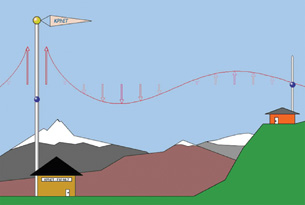Module 5
1. Module 5
1.5. Page 3
Module 5—Wave Theory of Light
 Read
Read
Read pages 641–643 of your textbook for more information on Maxwell’s Electromagnetic Theory.
 Try This
Try This
TR 1. Why is change important in producing EMR?
 Module 5: Lesson 1 Assignment
Module 5: Lesson 1 Assignment
Remember to submit your answers to A 5 and A 6 to your teacher as part of your Module 5: Lesson 1 Assignment.
A 5. Where does the energy for the EMR originate?
A 6. What new concept did Maxwell introduce?
 Try This—Producing, Transmitting and Receiving EMR
Try This—Producing, Transmitting and Receiving EMR
Electromagnetic waves were first produced and detected in 1887, shortly after Maxwell’s death. German physicist Heinrich Hertz (1857–1894) used a spark gap to rapidly move an electric charge back and forth producing a wave of 109 Hz, which was detected by a nearby antenna. He was also able to confirm that the waves travelled at nearly 3.0 × 108 m/s. Hertz called these electromagnetic waves “radio” waves. For his significant contribution to the study of science, the SI unit of frequency Hertz, or Hz (cycles per second or seconds–1), was named in his honour. Today, radio waves are very common. AM/FM radios, cellphones, garage-door openers, and cordless telephones operate in the radio range of the spectrum. You will explore how they are produced, transmitted, and received using your own radio station.
Use the Radio Waves simmulation to open your own radio station.

© 2008 University of Colorado. All rights reserved.
Your radio station has a transmitting tower that consists of an electron in a long conductor. Your listening audience is in the small house with a receiver attached to a long conducting antenna.
Select “Manual” on the Transmitter Movement menu and wiggle the electron in the transmission tower. Observe the correlation to the wave that is produced. Next, select "Oscillate" and observe the simple harmonic motion of the electron.
 Self-Check
Self-Check
SC 4. Does the frequency of the simple harmonic motion match the frequency of the radio wave?
SC 5. What causes the electron to accelerate up and down in a real transmission antenna? Explain how this will be related to the frequency of the radio wave produced.
SC 6. Describe the relationship of the direction of the electric wave, the magnetic wave, and the direction of the EMR.
 Self-Check Answers
Self-Check Answers
Contact your teacher if your answers vary significantly from the answers provided here.
SC 4. The frequency of oscillation in the transmitter tower matches the frequency of the emitted radio wave, in both manual and oscillation modes. The sine wave that is produced is a perfect representation of the acceleration of the electron in the conductor.
SC 5. In a real transmission tower, an electrical potential difference causes the electrons to accelerate. Oscillating the electrical potential difference results in an identical oscillation of the charge, producing a matching sine wave of EMR that propagates outwards.
SC 6. The electric wave, the magnetic wave, and the direction of the EMR are all at 90° to each other, like the x, y, and z axes of a Cartesian coordinate system. One example of the infinite possibilities of the relationship, if the wave were to move into the page, would be that the electric field could oscillate up and down and the magnetic field could oscillate left and right.
 Read
Read
Read pages 644–647 of your textbook for more information on Hertz’s experiment and radio technology.
 Discuss
Discuss

© Dan Briški/shutterstock
Shadows are the result of visible light being unable to pass through solid objects. Gamma rays and radio waves, on the other hand, are on opposite ends of the spectrum, yet they can both pass through solid walls. Visible light is in the centre of the spectrum in terms of frequency and energy, yet it cannot pass through a wall or solid object.
D 1. Why is this? Research and post a solution to this problem. In your explanation, explain how you would determine the smallest possible object you could see with visible light. You may wish to include a diagram to clarify your response. The suggested Internet search phrase, “Why can’t light travel through walls,” may help with your research.
D 2. Post your summary to the discussion area set up by your teacher. Compare your summary to at least one other explanation produced by another student. Identify similarities and differences between your work and the work of other students. Remember to add the answer to this question to your course folder.
 Module 5: Lesson 1 Assignment
Module 5: Lesson 1 Assignment
Remember to submit your answer to D 3 to your teacher as part of your Module 5: Lesson 1 Assignment.
D 3. If you were to update your explanation of why light can’t travel through walls based on what you learned in D 2, what changes would you make?
Discussion Scoring Guide
| Principles involved: wavelength, frequency, waves, and light | ||||
Criteria |
Level 1 |
Level 2 |
Level 3 |
Level 4 |
Knowledge |
||||
Demonstrates a vague and sometimes incorrect understanding of the physics principles involved. Obvious irrelevant or missing information. |
Demonstrates a basic understanding of the physics principles involved. May exhibit minor mistakes or vague information or application to the situation. |
Demonstrates a good understanding of the physics principles involved and applies them properly to the given situation. All necessary information is given. |
Demonstrates a superior understanding of the physics principles involved and their application to the situation. All applications are considered in detail. |
|
Reflection |
||||
The post shows reflection on one’s own and other students’ work. Contributes to the group discussion. |
Does not make an effort to participate. Seems indifferent to discussion. |
Occasionally makes meaningful reflections on the group’s efforts or discussions. Marginal effort is shown to become involved with the group or discussion. |
Frequently makes meaningful reflections on the group’s efforts and presents relevant viewpoints for consideration by the group. Interacts freely with group members. |
Regularly attempts to motivate the group discussion and delve deeper into concepts. Interacts freely and encourages all group members. |
Content and presentation of discussion summary |
||||
The information is logically arranged in a clear and concise manner. |
The information is poorly organized with many concepts implied. Irrelevant or rambling sentences make reading difficult. |
The information is somewhat organized with implied concepts. Excessive words or awkward sentences are used, which hinder reading. |
The information is well-organized and logically arranged. All concepts are explicitly explained. There are a few awkward but understandable sentences. |
The information is well-organized and very easy to understand. Well-worded sentences make reading pleasurable. |